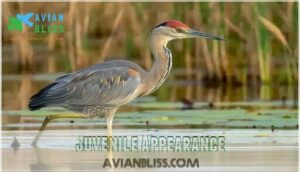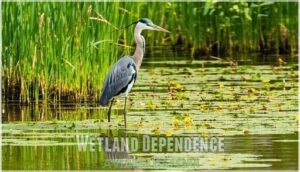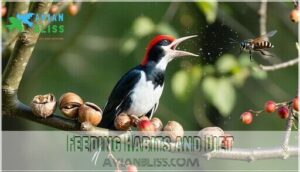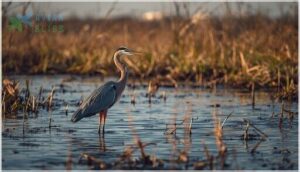This site is supported by our readers. We may earn a commission, at no cost to you, if you purchase through links.
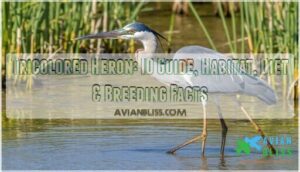
These graceful waders prefer coastal marshes, mangroves, and shallow lagoons where they hunt with a distinctive stop-and-go technique.
Unlike their gregarious cousins, tricolored herons are loners who wade belly-deep, methodically stalking fish, crabs, and shrimp that make up nearly their entire diet.
During breeding season, they sport elegant plumes and rusty patches on their wings.
These medium-sized herons measure about two feet tall with a three-foot wingspan, making them smaller than great blue herons but larger than snowy egrets.
Their patient hunting style and coastal preferences make identification straightforward once you know their signature features.
Table Of Contents
- Key Takeaways
- Tricolored Heron Identification
- Habitat and Range
- Feeding Habits and Diet
- Breeding and Nesting
- Conservation Status
- Frequently Asked Questions (FAQs)
- Are Tricolored Herons rare?
- What is the difference between a great blue heron and a Tricolored Heron?
- How do you identify a Tricolored Heron?
- What is the difference between a great blue heron and a tricolored heron?
- Where are Tricolored Herons found?
- What do Tricolored Herons eat?
- What does a tricolored heron look like?
- Where do tricolored herons live?
- What does a tricolored heron eat?
- What does a white heron look like?
- Conclusion
Key Takeaways
- You’ll easily identify tricolored herons by their distinctive slate-blue head and wings contrasting with bright white underparts and a characteristic white stripe running down their slender neck.
- You’ll find these solitary hunters prefer coastal marshes and shallow wetlands where they wade belly-deep, using active chase-and-pursuit techniques rather than the patient waiting style of other herons.
- You’ll notice they’re medium-sized birds measuring about two feet tall with a three-foot wingspan, making them smaller than great blue herons but larger than snowy egrets.
- You’ll see their conservation status varies by region—globally stable but declining in key areas like Florida (listed as state-threatened) due to habitat loss, wetland development, and pollution impacts on their specialized coastal environments.
Tricolored Heron Identification
You’ll easily recognize a Tricolored Heron by its distinctive slate-blue head and wings contrasting sharply with bright white underparts—it’s the only dark heron sporting this light belly.
This striking wader stands out as the only dark heron with a brilliant white belly.
Look for the characteristic long, slender neck with a white stripe running down the front, paired with a sharp, dagger-like bill that’s yellow at the base with a dark tip.
Physical Characteristics
You’ll spot a tricolored heron by its distinctive body measurements of 22-30 inches in length with a 36-38 inch wingspan.
The bird’s appearance showcases striking plumage coloration—slate-blue head and wings contrasting with bright white underparts.
Its bill morphology features a long, dagger-like shape that’s yellow with a dark tip, and its leg color varies from yellow to pink seasonally.
Sexual dimorphism is minimal between males and females.
Adult Plumage
Adult tricolored heron plumage showcases striking color variations that make bird identification straightforward.
You’ll notice their distinctive slate-blue head and wings contrasting with bright white underparts and throat.
During breeding season, seasonal changes bring dramatic breeding plumes on the head and back, while their bill transforms from yellow to brilliant blue.
The purplish-chestnut neck stripe remains constant year-round, serving as a key plumage function for species recognition among wading birds.
Juvenile Appearance
When identifying young tricolored herons, you’ll notice their juvenile plumage differs dramatically from adults.
These immature birds showcase distinctive coloring that makes bird identification straightforward:
- Reddish head with rusty-orange neck feathers
- Rust spots scattered across wings and body
- Slaty backs with blue-gray coloration
- Immature colors that lack adult white underparts
This juvenile appearance helps birders distinguish young tricolored herons from other species during their first year.
Distinctive Features
Beyond the tricolored heron’s striking plumage details—that signature white stripe cutting through its rusty neck—you’ll notice several key features that set Egretta tricolor apart.
The bird’s distinctive S-curved neck posture creates an unmistakable silhouette, while its bill coloration shifts from yellow to brilliant blue during breeding season.
For size comparison, these medium-sized herons measure roughly two feet tall with yellowish legs that turn pink when romance calls.
Habitat and Range
You’ll find tricolored herons in shallow wetlands across the southeastern United States, from Texas to Virginia, with year-round populations in Florida and the Gulf Coast.
These adaptable birds thrive in salt marshes, freshwater ponds, mangrove swamps, and tidal creeks where they can wade easily through water that’s typically less than two feet deep, making them well-suited to their shallow environments.
Preferred Environments
You’ll find tricolored herons thriving in diverse coastal wetlands and freshwater habitats where they can exploit their impressive salinity tolerance.
These adaptable coastal birds frequent shallow marshes, mangrove swamps, estuaries, and lagoons. Unlike many herons, they’re comfortable wading through both brackish and fresh water environments.
Habitat restoration efforts focus on protecting these critical wetland ecosystems, as climate impacts increasingly threaten their preferred shallow-water foraging grounds throughout their range, which requires preserving coastal birds and their shallow-water habitats.
Geographic Distribution
You’ll discover tricolored herons across the southeastern United States, with their strongest populations along the Gulf Coast and Atlantic shorelines.
These coastal birds show fascinating regional variations, from Florida’s year-round residents to migratory populations that push northward during breeding season.
Range expansion continues as habitat connectivity improves, though population density remains highest in traditional strongholds like Louisiana’s marshes and Texas estuaries, where ideal conditions support thriving heron communities.
The combination of these factors contributes to the overall health and population density of the heron species in these areas.
Wetland Dependence
Depending entirely on healthy wetlands, tricolored herons face serious challenges from habitat loss and pollution effects.
Healthy wetlands mean thriving herons—without them, these elegant birds simply vanish.
You’ll find these wetland birds struggling as hydrology impacts alter their foraging areas, reducing prey abundance through habitat fragmentation.
Wetland conservation efforts are critical—without protected marshes and swamps, heron habitat disappears.
Development pressures continue threatening these specialized environments where tricolored herons have thrived for millennia, and these efforts are essential, as wetland types matter for supporting diverse bird species.
Feeding Habits and Diet
You’ll find tricolored herons are surprisingly active hunters, using their sharp bills like underwater spears to snatch fish, crabs, and insects from shallow waters.
These skilled foragers prefer working alone, often chasing away competitors while they wade belly-deep through marshes and coastal areas searching for their next meal, utilizing their sharp bills like underwater spears.
Foraging Techniques
You’ll spot tricolored herons employing remarkably active hunting strategies compared to their more patient relatives.
These solitary feeding specialists defend prime territory against competitors while wading belly-deep in shallow waters.
Their bird foraging techniques include:
- Chase and pursuit – actively running after fleeing fish
- Stirring sediments – disturbing mud to flush out aquatic prey
- Stand-and-wait – remaining motionless before lightning-fast prey capture
This energetic bird foraging approach maximizes prey abundance opportunities in their wetland territories.
To best observe these behaviors, consider using specialized birding equipment.
Prey Species
You’ll find these herons aren’t picky eaters in regard to aquatic prey.
Their bird diet consists mainly of small fish, but they’ll happily snack on whatever swims or crawls nearby.
Fish abundance directly impacts their foraging success, while crustacean variety and insect consumption round out their menu.
| Primary Prey | Secondary Options |
|---|---|
| Small fish (90-99%) | Amphibians & frogs |
| Killifish & minnows | Small reptiles & lizards |
| Crabs & prawns | Aquatic insects |
Aquatic Invertebrates
You’ll spot tricolored herons consuming prawns, crabs, snails, and insect larvae when fish aren’t plentiful.
These aquatic invertebrates make up 10-20% of their diet composition, especially during droughts. Their prey selection shifts based on invertebrate abundance in foraging areas.
Watch them use foot-stirring techniques to flush invertebrates from sediments, impacting trophic levels through this specialized bird diet strategy.
These birds are also known as Egretta tricolor, utilizing a unique approach to their diet composition.
Fish and Crustaceans
Fish form the backbone of the tricolored heron’s diet, comprising 90-99.7% of their intake.
You’ll see them targeting killifish, topminnows, and minnows in shallow foraging areas.
Crustaceans like crabs and prawns round out their menu.
Unfortunately, wetland development and pesticide exposure threaten prey abundance, while oil spills contaminate critical feeding zones, disrupting foraging hydrology these birds depend on.
Breeding and Nesting
You’ll witness one of nature’s most fascinating collaborative efforts when tricolored herons begin their breeding season from February through August.
These elegant waders form bustling colonies alongside other waterbirds, where males perform elaborate displays to attract mates.
Before females construct intricate nests using materials their partners dutifully gather, the males have already performed their roles in attracting mates and gathering materials, which is a complete and elaborate process.
Nest Construction
Tricolored heron nesting begins when males select prime spots in wetland colonies, gathering sticks and twigs as nest materials.
You’ll find these birds building platforms 3-15 feet high in shrubs or trees near water. Males contribute by collecting building supplies while females weave the structure.
Colony dynamics influence nest location choices, with birds often clustering together for protection. Nest reuse isn’t common, as these breeding birds typically construct fresh platforms each season in their bird habitat.
These platforms are sometimes sold as decorative bird nests.
Incubation and Chick Rearing
Both parents share egg incubation duties for 21-25 days, taking turns warming their pale blue-green clutch.
During chick development, parents alternate feeding responsibilities, regurgitating small fish and aquatic invertebrates directly into hungry beaks.
To guarantee healthy growth, consider specialized heron chick food.
Young nestlings remain in the nest for approximately five weeks, with fledgling success depending on consistent parental care and adequate food supply throughout the nesting period.
Colony Breeding
Unlike solitary hunters, tricolored herons embrace community living when it’s time to breed.
These birds gather in bustling breeding colonies alongside other wading bird species, creating vibrant neighborhoods where hundreds of pairs nest together.
Colony formation provides safety in numbers, with coordinated nesting synchrony helping protect vulnerable chicks from predators.
Parents take turns with parental roles while the entire colony maintains collective defense against threats.
Making these communal sites essential for successful chick development is crucial, as the entire colony works together to ensure the young have the best chance of survival.
Egg Clutch Size
A typical tricolored heron’s breeding success hinges on clutch size variation, with females laying 3-5 pale bluish eggs per nesting attempt.
Environmental factors like water levels and food abundance directly influence parental investment decisions. Both parents share bird incubation duties for 21-25 days, ensuring proper egg development.
This cooperative approach maximizes chick survival rates, though asynchronous hatching creates size differences among siblings within the same clutch.
These herons are state-designated as threatened in Florida.
Conservation Status
While you might assume this striking bird is thriving, tricolored herons face significant conservation challenges across their range.
The species holds a complex status—globally stable but regionally threatened, particularly in Florida where it’s listed as state-threatened due to dramatic population declines.
Population Trends
Nationwide monitoring efforts reveal concerning population trends for the tricolored heron, with breeding pairs declining 0.4% annually since 1966.
Regional declines hit hardest in traditional strongholds like Florida’s Everglades, where breeding pairs dropped 75% between 1996-2010, and Texas shows steeper losses at 3% yearly.
While some northern areas gained birds, overall population stability requires urgent wetland protection to reverse these troubling bird conservation trends across critical wetland habitats.
Environmental Challenges
You’ll face mounting environmental threats that put tricolored herons at serious risk.
Wetland development destroys critical nesting sites, while pollution exposure from pesticides and mercury causes reproductive failures.
Hydrology alterations reduce prey availability, forcing birds to compete for limited food sources.
Oil spills contaminate feeding areas, and pollutants accumulate in tissues, weakening immune systems and causing thin eggshells that threaten breeding success.
These herons are also threatened, as habitat loss increases, impacting nesting and feeding grounds, due to habitat loss and other factors that affect their breeding success and overall immune systems.
Habitat Loss and Degradation
Wetland development poses the greatest threat to tricolored heron populations across their range.
You’ll find these birds losing critical foraging areas as coastal marshes disappear under concrete and asphalt.
Pollution impacts from agricultural runoff and urban development contaminate remaining wetlands, reducing prey abundance through chemical contamination.
Habitat fragmentation breaks up once-continuous marsh systems, forcing birds to travel greater distances between feeding and nesting sites, which increases energy expenditure and reduces breeding success.
Threats to Nesting Colonies
Nesting colonies face mounting pressures that threaten tricolored heron reproduction.
Colony disturbance from recreational boating and fishing forces adults to abandon nests, leaving eggs vulnerable to predators.
Habitat fragmentation isolates breeding sites, while pollution impacts from oil spills and chemical runoff harm chick survival.
Hydrology alterations reduce prey abundance, and mammalian predators like raccoons destroy up to 94% of nests in some areas.
Frequently Asked Questions (FAQs)
Are Tricolored Herons rare?
Tricolored Herons aren’t exactly rare globally—they’re listed as "Least Concern" internationally. However, you’ll find they’re considered threatened in Florida, where populations have declined substantially in recent decades.
What is the difference between a great blue heron and a Tricolored Heron?
Though both appear similar, you’ll spot key differences easily.
Great Blue Herons tower much larger with all-gray plumage, while Tricolored Herons sport distinctive white bellies contrasting their slate-blue backs, making identification straightforward with complete concepts.
How do you identify a Tricolored Heron?
Look for a medium-sized heron with distinctive contrasting colors: slate-blue head and wings, bright white underparts, and a white stripe down the neck.
You’ll spot long yellow legs and a sharp, dark-tipped bill.
What is the difference between a great blue heron and a tricolored heron?
Like spotting a chameleon versus a uniform coat, you’ll notice great blue herons are entirely blue-gray while tricolored herons sport striking white bellies contrasting their dark blue-gray backs.
Where are Tricolored Herons found?
You’ll find these elegant waders throughout coastal areas of the southeastern United States, from Texas to North Carolina, plus the Caribbean and Central America during breeding season.
What do Tricolored Herons eat?
You’d expect such elegant birds to dine delicately, but tricolored herons are actually opportunistic feeders.
They primarily consume fish, crustaceans, insects, amphibians, and small reptiles, spearing prey with their sharp bills.
What does a tricolored heron look like?
You’ll recognize this striking heron by its dark slate-blue head and upper body contrasting sharply with bright white underparts.
It displays a distinctive white stripe down its slender neck, long yellowish legs, and a pointed bill that’s dark-tipped but yellow at the base.
Where do tricolored herons live?
You’ll find tricolored herons throughout wetlands, marshes, coastal areas, and shallow waters across the southeastern United States, particularly thriving in Florida’s diverse aquatic habitats and extending northward along Atlantic coastlines.
What does a tricolored heron eat?
Fish make up 90-7% of their diet, showing you’re watching nature’s most specialized fishermen in action.
You’ll spot them stalking minnows, killifish, crabs, and aquatic insects in shallow waters, using their dagger-like bills to snatch prey with lightning-quick strikes.
What does a white heron look like?
White herons typically display pure white plumage across their entire body, contrasting sharply with their long, slender yellow or orange bills and dark legs, creating an elegant silhouette.
Conclusion
Recognizing a tricolored heron becomes second nature once you’ve mastered their signature field marks.
You’ll confidently distinguish these solitary coastal specialists from other wading birds by their unique white neck stripe, patient hunting behavior, and distinctive blue-gray plumage.
Whether you’re observing their methodical foraging technique in shallow wetlands or spotting their elegant breeding plumes during nesting season, the tricolored heron’s unmistakable characteristics make field identification straightforward for any dedicated birdwatcher.



